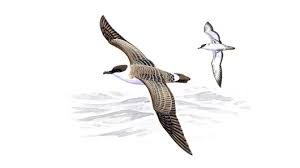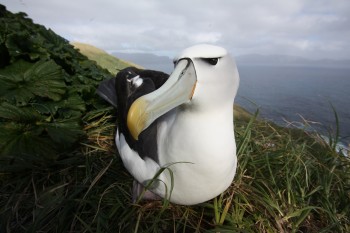Kevin Powers (Stellwagen Bank National Marine Sanctuary, Scituate, Massachusetts, USA) and colleagues have published in the journal Marine Ecology Progress Series on tracking Great Shearwaters Ardenna gravis in the Gulf of Maine.
“In the western North Atlantic, great shearwaters Puffinus gravis are among the most abundant seabirds during summer months, yet little is known about their movement ecology and habitat requirements in this ecosystem. We deployed platform terminal transmitters on shearwaters captured in the Gulf of Maine and used a Bayesian switching state-space model to describe bird movements, behavior, foraging areas, migration timing, and how such habitat use and movements might be related to age. From July to November, great shearwaters traveled an average of 515 km per week and spent most of their time foraging around the rim of the gulf, primarily using shallower waters (<100 m), where bathymetry was more steeply sloped. A generalized additive model fit to these foraging locations data revealed correlations between foraging habitat use and depth, chlorophyll a and sea surface temperature, but not slope. Interestingly, these relationships were not consistent across birds from different tagging sites, suggesting a flexible foraging strategy based on local habitat conditions and high mobility. Movements associated with the shearwaters’ southern migration began in August and continued through much of September, with birds leaving the study area via a pathway south of Nova Scotia, Canada. Nape plumage analysis showed most of the captured birds in the Gulf of Maine were young birds; 89% were <3 yr old. These results suggest that modeling shearwater location information using state-space models can be useful in identifying discrete, high-use habitat patches as part of efforts to reduce fishery bycatch.”

Great Shearwaters, courtesy of the Royal Society for the Protection of Birds
Reference:
Powers, K.D., Wiley, D.N., Allyn, A.J., Welch, L.J. & Ronconi. R.A. 2017. Movements and foraging habitats of great shearwaters Puffinus gravis in the Gulf of Maine. Marine Ecology Progress Series 574: 211-226.
John Cooper, ACAP Information Officer, 26 July 2017

 English
English  Français
Français  Español
Español 


